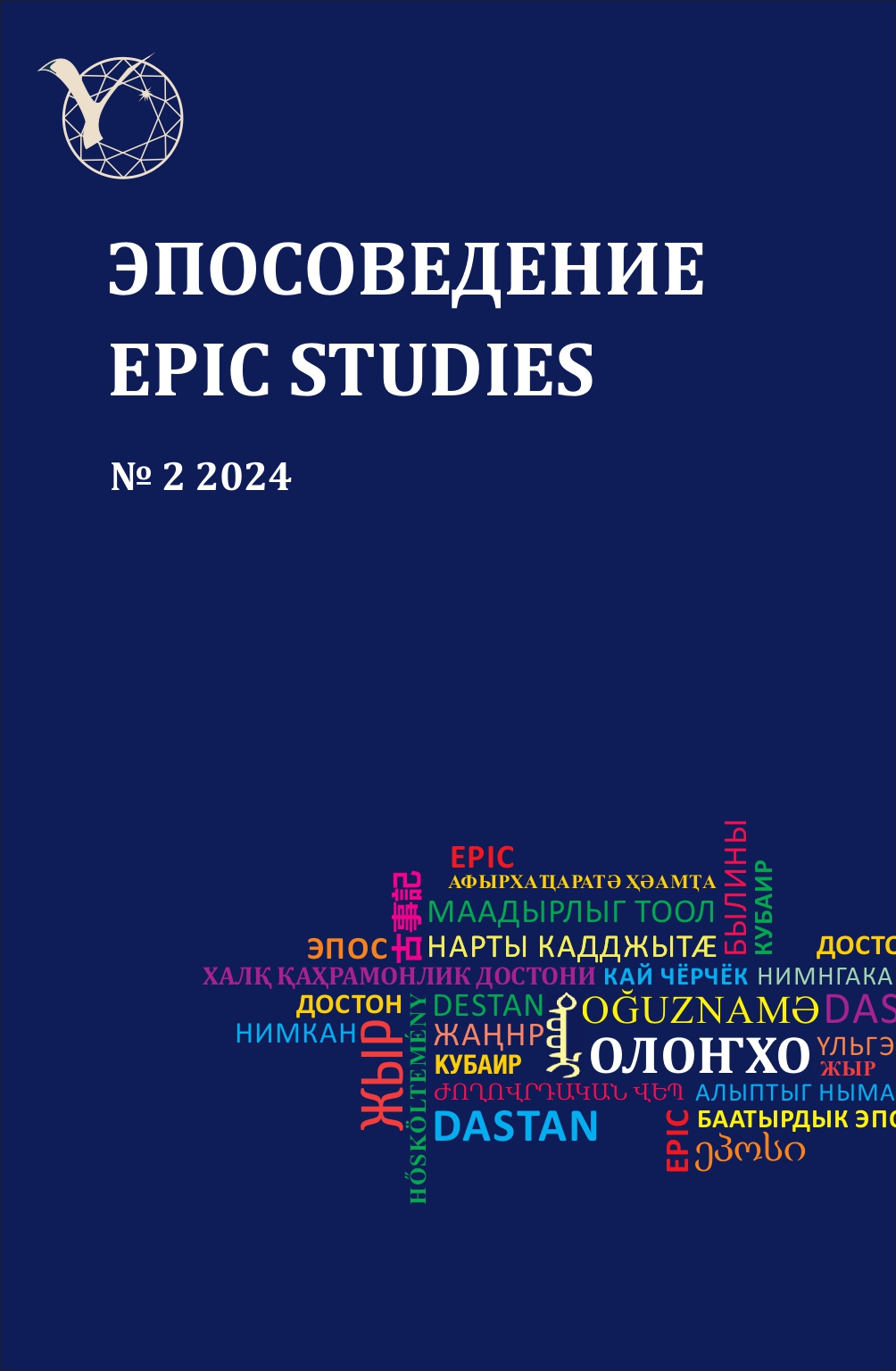Interpretation of the ancient Yakut folklore text
DOI:
https://doi.org/10.25587/2782-4861-2024-2-77-85Keywords:
folklore; 18th century; expedition; G. W. Steller's recordings; folk song; Yakuts; interpretation; artistic and visual means; fixation; textologyAbstract
The author deals with the text of an archival document discovered in the materials of the Second Kamchatka expedition led by Vitus Bering, in the collection of field notes of the expedition member, the German doctor and translator G. W. Steller. This fragment in Latin is a recording of a Yakut folk song of the first half of the 18th century. The purpose of this article is to introduce a previously unpublished archival text into scientific circulation by translating the text and describing its artistic features. As part of the research, the following tasks were set: to study the history of the text, give a description of the manuscript, transcribe and translate it into Russian and highlight the artistic means used. According to the fixation of Yakut folklore in the specified period is known to science the ethnographic work of J. J. Lindenau “Description of the nations of Siberia,” which contains the text of the algys ritual on the Ysekh holiday. There are also recordings of folk songs of northern nations performed by G. W. Steller, but this text has not yet been examined by folklorists. The work uses theoretical and practical research methods as: study of scientific works, the main research method is textual analysis, which uses the method of review, description, interpretation, connection, translation, decoding and analysis of the composition, artistic and visual means of the text. The author concludes that the ancient folk song has a developed syllable. Rhythmic alliterative verse, consonance of line endings close to varieties of rhyme, parallel constructions, constant epithets and comparisons as the main means of depiction demonstrate a fairly high level of development of Yakut folk poetry. The author sees the prospect of research in the discovery of similar texts of the specified period, which would allow more in-depth research in this area.
References
1. Materials of the Kamchatka expedition. In: Saint Petersburg branch of the Archive of the Russian Academy of Sciences. F. 21, op. 5, 114 s. (In Rus.)
2. Ivanov, V. F. Historical and ethnographic study of Yakutia in the 17th–18th centuries. Moscow, Nauka Publ., 1974, 187 p. (In Rus.)
3. Miller, G. F. History of Siberia. V. 1. Moscow, Leningrad, USSR Academy of Sciences Publ., 1937, 684 p. (In Rus.)
4. Steller, G. V. Description of the land of Kamchatka. Petropavlovsk-Kamchatsky, Holding Company “New Book”, 2011, 576 p. (In Rus.)
5. Lindenau, Ya. I. Description of the peoples of Siberia (first half of the 18th century): historical and ethnographic materials about the peoples of Siberia and the North-East. Translation from German, preparation of the text, notes and preface by Z. D. Titova; under the general editorship of I. S. Vdovin. Magadan, Book Publ. House, 1983, 176 p. (In Rus.)
6. Ksenofontov, G. V. Uraakhai-sakhalar: in 2 books. V. 1: Essays on the ancient history of the Yakuts. Yakutsk, Bichik Publ., 1992, 416 p. (In Rus.)
7. Titova, Z. D. Historical and ethnographic description of the peoples of Kamchatka in the 18th century. in the works of G. W. Steller. Description of the peoples of Siberia (first half of the 18th century): Historical and ethnographic materials about the peoples of Siberia and the North-East. Magadan, Book Publ. House, 1983, 176 p. (In Rus.)
8. Polevoy, B. P. G. V. Steller and his “Description of the land of Kamchatka.” Georg Wilhelm Steller. Introductory article to the book “Description of the Land of Kamchatka”. Petropavlovsk-Kamchatsky, Kamchatsky Printing Yard, 1999, 288 p. (In Rus.)
9. Chernavskaya, V. N. Participant of the second Kamchatka expedition of Bering (to the 300th anniversary of the birth of G. W. Steller). Russia and the Asia-Pacific region. 2009, No. 2 (64), pp. 86–92. (In Rus.)
10. Shishigina, A. N. Scientific study of Yakutia in the 18th century: (based on materials from the Second Kamchatka Expedition). Yakutsk, YSC SB RAS Publ. House, 2005, 299 p. (In Rus.)
11. Lendenev, V. S. Our ancestor Jacob Johann Lindenau [Web resource]. URL: http://www.kamchadaly.ru/fio/print.php?t_name=kamchad_pub&id_cont=210&title=Our+ancestor+Jacob+Johann+Lindenau. (Accessed April 1, 2024). (In Rus.)
12. Limorenko, Yu. V. Editorial textual criticism of folklore and practice. Siberian Philological Journal. 2021, No. 2, pp. 9–17. (In Rus.)
13. Zhirmunsky, V. M. Theory of verse. Edition 2. Moscow, URSS Publ., 2023, 666 p. (In Rus.)
14. Vasiliev, G. M. Living spring: about the oral poetry of the Yakuts. Yakutsk, Book Publ. House, 1973, 303 p. (In Rus.)
15. Toburokov, N. N. Works on Turkic versification. Yakutsk, NEFU Publ. House, 2018, 504 p. (In Rus.)
16. Pokatilova, N. V. Poetic beginning in folklore text: mythopoetic aspect. Epic Studies. 2022, No. 4, pp. 5–15. DOI: 10.25587/SVFU.2022.16.81.001. (In Rus.)
17. Alekseev, I. E. The beauty of native speech. Editor A. K. Prokopyeva. Yakutsk, NEFU Publ. House, 2023, 318 p. (In Yakut).
18. Georg Wilhelm Steller [Web resource]. URL: https://kamlib.ru/resources/full_text_search/vydayushchiesya-lichnosti-v-istorii-kamchatki/detail/georg-vilgelm-steller/. (Accessed April 1, 2024)
19. Lantzeff, G. V, Pierce, R. A. Eastward to Empire: exploration and Conquest on the Russian Open Frontier to 1750. Montreal, London, McGill-Queen’s University Press, 1973, 276 p.
Downloads
Published
How to Cite
Issue
Section
License
Copyright (c) 2024 EPIC STUDIES

This work is licensed under a Creative Commons Attribution 4.0 International License.
Copyright (c) 2021 Copyright (c) This work is licensed under a Creative Commons Attribution 4.0 International License.










 Olonkho Research Institute, M.K. Ammosov North-Eastern Federal University
Olonkho Research Institute, M.K. Ammosov North-Eastern Federal University